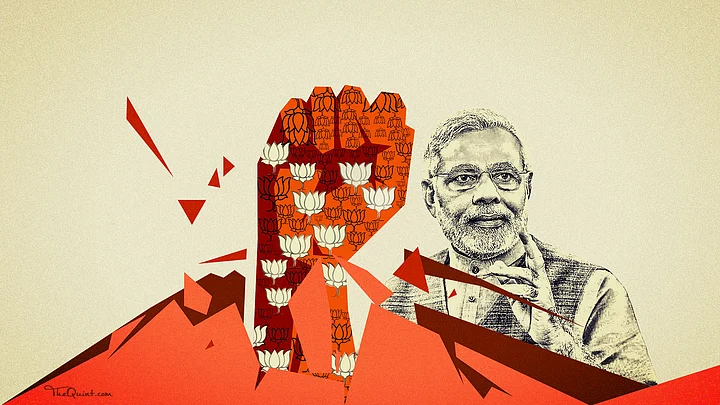While campaigning in Fatehpur, Uttar Pradesh on Sunday, Prime Minister Narendra Modi made an explosive statement.
“If there is land given to build kabristan (graveyards), land should also be given for shamshaans (crematoria),” he said. The implication was not lost on anyone: Muslims are buried; Hindus, cremated.
He went on to add, “If electricity is supplied during Ramzan, it should also be supplied during Diwali.” Indirectly accusing the ruling Samajwadi Party (SP) of favouring Muslims, he added, “This politics of division must end.”
Also Read: From ‘Mandir’ to ‘Shamshaan’: Twitter Slams Modi’s Idea of ‘Vikas’
Resorting to Polarisation
With three phases of elections in UP now over, Modi’s campaign has taken a sharp turn towards religious polarisation, a far cry from his initial promises of bringing better administration to UP and ridding India of graft through his 8 November 2016 decision to scrap 86 percent of India’s currency by value.
With four phases of polling to go, why has Modi shifted from the messiah of development, governance and anti-graft campaigner, to communal rabble-rouser? A source in the BJP’s UP campaign ‘war room’, requesting anonymity, grumbled that in the first phase in Jat and Gujjar-dominated western UP, the BJP was uncertain that these castes would back it as they did in 2014.
The second phase in Rohilkhand had support for Mayawati’s Bahujan Samaj Paty (BSP). In both these phases, feedback from the ground about the effects of ‘notebandi’ on farm, local industry and trade was overwhelmingly negative, forcing Modi to drop references to demonetisation.
The third phase in the Yadav-dominated Awadh area is the stronghold of Akhilesh Yadav-led Samajwadi Party (SP), where Modi had promised to replace the so-called anarchy unleashed by the SP, with better administration. But that line has been pushed by the BSP’s low-profile but intense campaign, which began well before polls were announced.
Also Read: Modi’s ‘Kabristan’ Remark Draws Ire, Congress to File EC Complaint
Changing Pitch from ‘Vikas’ to Communalism
“Despite having 71 Lok Sabha MPs from the state, organisation is weak and BJP has distributed tickets to ‘dal-badlus’ (defectors from other parties) which has angered those who worked for the party for years,” said the strategist.
One notable turncoat is Rita Bahuguna Joshi, former Congress chief of UP and incumbent Congress MLA from Lucknow Cantonment, who is now contesting as a BJP candidate.
This is not the first time Modi has shifted tack from development to trying to create a divide between Hindus and Muslims. Two years ago, during the five-phase election in Bihar, when the BJP realised it was up against a formidable alliance of Lalu Yadav’s RJD, Nitish Kumar’s JD(U) and Congress, Modi shifted gear midway through the campaign.
He warned that the alliance would snatch away 5 percent of reservation from (Hindu) lower castes and redistribute it among “another religious community”. Everybody understood which “other community” he was referring to. In any event, the BJP flopped in Bihar.
If Modi has reverted to communal atavism, he and campaign manager Amit Shah must have realised that the BJP’s dream of returning to power in UP after 15 years looks like a mirage.
Also Read: If a Kabristan Can be Constructed, so Should a Shamshaan: PM Modi
BJP’s ‘Vanvas’ May Last a Little Longer
Indeed, going by past numbers and a recent survey, the BJP’s chances don’t look good. Data shows that in multi-polar contests in UP, any party which gets 30 percent votes forms the government: indeed, the SP won a convincing majority in 2012 with only 29 percent of votes.
In alliance with Congress vote shares, the results are compelling. A 16 February report released by global brokerage Credit Suisse combines voting data from the Election Commission (EC), and respected election surveyor CSDS, to come up with interesting results.
Assuming the SP-Congress alliance had been in place from 2012, it would have got 41 percent of all votes, followed by the BSP which got 26 percent with the BJP a distant third with 15 percent. In 2014, with the Modi wave at its peak, the BJP got 42 percent of votes, with the alliance a respectable 30 percent: this could have denied BJP its staggering 71 of 80 Lok Sabha seat tally. So what is the likely vote share in 2017?
A CSDS survey was done before the alliance was announced. But simply adding the projected SP and Congress votes gives the alliance a staggering 38 percent of votes, enough to win a comfortable victory over second-place BJP, trailing at 27 percent.
Consolidating the Hindu Vote
Luckily, CSDS also collects caste- and religion-wise polling data. During 2014’s Modi wave, BJP won 76 percent of upper caste votes, 49 percent of OBC votes and even 29 percent of (probably non-Jatav) Dalit votes, which BSP takes for granted. Even 10 percent of Muslims voted BJP.
Since then, things have changed dramatically, according to the CSDS. BJP’s upper caste vote will drop to 55 percent; OBC votes to 27 percent; Dalits to 10 percent and Muslims to 9 percent.
The biggest losses will come from upper caste, OBC and Dalit voters. In all these categories, the BJP’s losses will accrue as gains to the SP-Congress alliance. With the alliance expected to mop up 61 percent Muslim votes, and the BJP’s share dropping to a measly 9 percent, Modi knows there’s no point going soft on minorities.
His only hope is to try and claw back as much of the Hindu vote as he can, by inflaming imaginary hurts and divisions among the two religious communities. Hence, the new rhetoric about kabristan-shamshaan, Ramzan-Diwali and Eid-Holi.
(The writer is a Delhi-based senior journalist. He can be reached @AbheekBarman. This is an opinion piece and the views expressed above are the author’s own. The Quint neither endorses nor is responsible for the same.)
Also Read: With Polarisation in West UP, Will BJP Repeat Its 2014 Landslide?
(At The Quint, we question everything. Play an active role in shaping our journalism by becoming a member today.)
